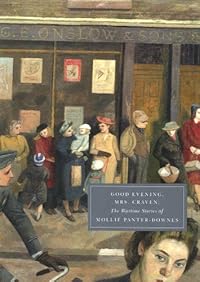One Fine Day by Mollie Panter-Downes was first published in 1947 but my copy is a 2011 Virago, how I hate those new Virago covers, bring back the original green ones, please.
This book was written in 1946, a time when everyone was trying to adjust to a normal life without war, it’s not made easy by the fact that everything post-war has changed, especially for those who had had some money and were used to servants looking after them. It’s a day in the life of Laura, a middle class wife and mother of Victoria, a ten year old. Laura’s not terribly domesticated and she’s a bit of a dreamer so she’s struggling to cope with cooking and mending.
Laura Marshall’s husband is getting into the routine of commuting by train to London from Wealding in Sussex every morning, but he’s also constantly worrying about the state of his garden and house, there’s no help to be found anywhere and it all seems to be crumbling around him.
This is so well written and observed, Panter-Downes has Laura comparing the differences between her middle class husband’s standoffish attitude to his own daughter and a local working class man’s obvious adoration of a young relative. They’re poverty stricken and slovenly, but happy. Of course Stephen had gone off to war, leaving a small girl behind and he’s having trouble recognising that wee one in the self-contained ten year old that she has become while he was at war for five years.
When Laura makes a visit to the local ‘big house’ she thinks:
All those windows, she thought in horror. For the rest of her life, now, she would see things from the point of view of cleaning them. Confronted by a masterpiece of architecture, she would think merely, How much floor to sweep, how many stairs to run up and down. The world had contracted to domestic-house size, always whispering to the sound of somebody’s broom.
There’s quite a lot of humour in the book, often in the way that the ‘lower orders’ express themselves. But Angela Huth who wrote an introduction to the book seems to have missed some of it, as she’s under the impression that the big house is being turned into some sort of institution.
In fact the family in the big house has decided to hand it over to the National Trust and retreat to a self-contained flat in the property, as many such stately home owners did around that time. Perhaps Huth didn’t understand the ‘joke’ that the charlady gives the information that National Trusses will be taking over the big house. Most of the humour is from the way the working class people speak but it isn’t really in any nasty condescending way.
It’s a very enjoyable read and I just hope that I can get my hands on more of her books. You can read her obituary here.


